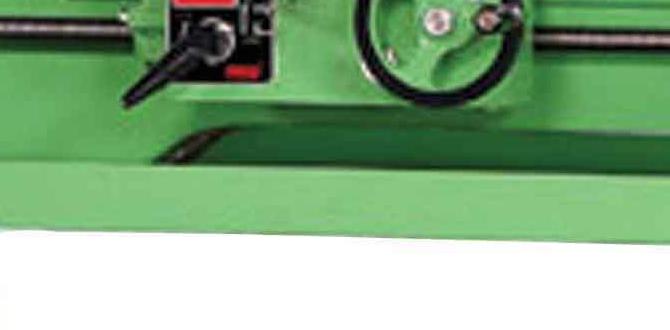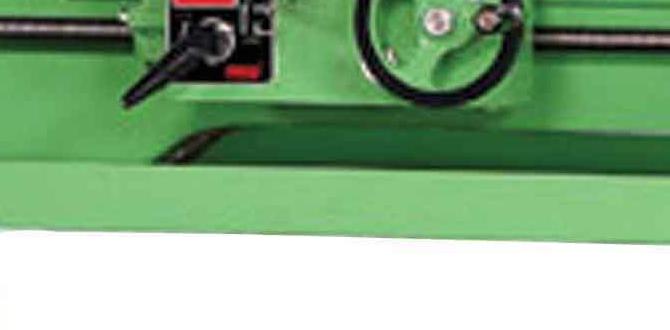Wood lathe vibration during bowl turning is a common annoyance that can ruin your projects. This guide offers straightforward fixes to smooth out your turning and get back to creating beautiful bowls. Don’t let wobbles stop you – we’ll help you achieve a stable, satisfying turning experience.
Wood Lathe Vibration During Bowl Turning: Essential Fixes
Hey there, fellow woodworkers! Daniel Bates here from Lathe Hub. If you’ve ever worked with a wood lathe, especially when turning bowls, you’ve probably felt it: that unsettling shimmy, that constant vibration that rattles your tools and your nerves. It’s frustrating, it can ruin a perfectly good piece of wood, and it can even be a safety hazard. But don’t worry! Many beginner turners experience this, and the good news is, it’s usually quite fixable. This article will walk you through step-by-step solutions to get your lathe running as smooth as silk.
We’ll cover everything from how you mount your wood to the condition of your lathe itself. By the end of this guide, you’ll have a clear understanding of why this vibration happens and, more importantly, how to get rid of it. Let’s get those bowls smooth and steady!
Why Does Wood Lathe Vibration Happen During Bowl Turning?
Vibration on a wood lathe, particularly during bowl turning, is like a persistent, unwelcome guest. It shows up when least expected and makes your work much harder. Understanding the common culprits is the first step to banishing it. Bowl turning presents unique challenges because you’re often working with larger, unbalanced pieces of wood, especially in the initial stages. These imbalances create forces that, if not managed, translate into those jarring vibrations you feel.
The core issue is often an imbalance between the rotating workpiece and the static lathe. This imbalance can be caused by several factors, including the shape of the wood, how it’s mounted, the condition of the lathe itself, and even your workshop environment. As you remove material, especially when roughing out a round shape from a square or irregular blank, the center of mass shifts dramatically. Your goal is to minimize these shifts and ensure everything is as stable as possible. We’ll dive into each of these in detail.
The Top Causes of Wood Lathe Vibration
Let’s break down the most frequent reasons for that bothersome shake:
- Unbalanced Workpiece: This is probably the most common cause, especially when starting with a square blank or a blank with significant out-of-roundness.
- Improper Mounting: How your wood is attached to the lathe is crucial. If it’s not centered or secured properly, it will wobble.
- Loose Lathe Components: Over time, parts of your lathe can loosen, leading to increased vibration.
- Lathe Bed Issues: A damaged or dirty lathe bed can prevent smooth operation.
- Tool Rest Position: If your tool rest is too far away or positioned incorrectly, it can exacerbate existing vibrations.
- Mounting Hardware: The chuck, faceplate, or drive center needs to be in good condition and securely fitted.
- Motor or Belt Issues: While less common for bowl turning specifically, a malfunctioning motor or worn belts can sometimes contribute.
- Workshop Environment: Believe it or not, an uneven floor or insecure workbench can even play a role.
Identifying which of these is contributing to your problem is key to a quick fix. Often, it’s a combination of a few!
Essential Fixes for Wood Lathe Vibration
Now for the good stuff – the solutions! We’ll tackle these one by one, starting with the most likely culprits.
1. Addressing the Unbalanced Workpiece
This is your first line of defense when turning bowls. An unbalanced blank is a vibrator’s best friend.
- Rough Shaping: Before mounting the wood, take it to a bandsaw and round off the corners as much as possible. Cutting off the corners reduces the uneven mass distribution. Imagine a square peg on a spinning rod versus a round peg; the round one will spin much more smoothly initially.
- Pre-drilling for Mounting: If you’re using screws for a specific mounting method (like a screw chuck or for attaching a faceplate), ensure the screw hole is drilled as close to the center as possible.
- Weight Distribution: For very large or irregular blanks, you might consider deliberately removing material from the heaviest side before mounting to get a rough balance. This is more advanced but can make a huge difference.
2. Mastering Proper Workpiece Mounting
This is absolutely critical. If your wood isn’t mounted correctly, no amount of tuning will completely solve vibration. Whether you’re using a faceplate, a chuck, or a drive center, precision matters.
Using a Faceplate
Faceplates are common for bowl turning. Here’s how to get it right:
- Center the Faceplate: Ensure the faceplate is perfectly centered on your blank. Use a compass or a center finder to mark the exact center of your blank.
- Secure the Blank to the Faceplate: Use sturdy wood screws. Position them so they pull the blank firmly against the faceplate. Use at least four screws for larger blanks. Make sure the screw heads are flush or slightly recessed.
- Mounting the Faceplate to the Lathe: Ensure the faceplate’s threaded shaft is clean and fits snugly into your lathe’s spindle. Tighten it securely.
External Link Tip: For more detailed information on wood mounting techniques, check out resources from woodworking organizations. For example, the American Association of Woodturners (AAW) often has excellent guides on their site, which is a great resource for understanding tool and material safety.
Using a Lathe Chuck
Chucks offer versatility but need proper jaw placement.
- Select the Right Jaws: Use jaws appropriate for the size and shape of your workpiece.
- Center the Blank (or Mount it Firmly): For larger bowls, you might mount the blank to a faceplate first, then chuck the faceplate. If chucking the blank directly, ensure it’s gripped evenly by the jaws all around.
- Check for Runout: After mounting, gently spin the lathe by hand. You can use a dial indicator for precision, or simply hold a pencil point near the edge to see how smoothly it rotates. A little wobble here is usually amplified dramatically during powered turning.
Using a Drive Center (for initial shaping of spindle work or tenons)
While less common for initial bowl blanks, a drive center needs care:
- Drill and Mount the Tenon: If you’re creating a tenon for a chuck, ensure it’s sized correctly for your chuck jaws and drilled in the center of the blank.
- Secure the Drive Center: The spur drive center needs to bite firmly into the wood. Ensure it’s seated properly and you’re not over-tightening, which can crack the wood.
3. Tightening Up Your Lathe
Even a great lathe can develop vibration if its components aren’t tight. Think of your lathe as a finely tuned instrument – every connection needs to be secure.
- Headstock and Tailstock: Check that the headstock and tailstock are securely locked in place. Ensure the tailstock is not protruding too far, as this can also introduce instability.
- Tool Rest Locking Mechanism: The tool rest must be locked firmly. A loose tool rest will bounce and chatter, and that vibration will transfer to your workpiece.
- Bed Clamps/Locking Handles: If your lathe has adjustable legs or bed sections, ensure all locking mechanisms are tight.
- Faceplate/Chuck Mounting: Reconfirm that your faceplate or chuck is screwed tightly onto the spindle.
4. Inspecting and Cleaning the Lathe Bed
The bed of your lathe is its foundation. Any debris or damage here can cause issues.
- Clean the Ways: Use a soft cloth to wipe down the ways (the tracks that the tailstock and tool rest slide on). Dust, chips, or dried lubricant can cause jerky movement and vibration.
- Check for Damage: Look for any dents or deep scratches on the ways. Minor issues can sometimes be smoothed out with fine abrasive paper, but significant damage might require professional attention or replacement parts.
- Lubrication: Follow your lathe manufacturer’s recommendations for lubricating the ways. Proper lubrication ensures smooth movement.
5. Optimizing Tool Rest Position
The tool rest isn’t just a place to rest your tools; it’s a critical support that influences vibration.
- Proximity is Key: Position the tool rest as close to the workpiece as possible without it hitting the wood during rotation. The closer it is, the more support it provides, and the less likely it is to allow vibration to build up. This is especially true when roughing out.
- Correct Height: The top of the tool rest should generally be at the height of the center of your workpiece. For some cuts, like scraping the inside of a bowl, you might lower it slightly, but for initial shaping, center height is usually best for stability.
- Angle: For turning outside curves, angle the tool rest slightly to follow the contour of the wood. For inside work, keep it closer to parallel with the tangent of the curve.
6. Checking Mounting Hardware Health
The components that attach your wood to the lathe are vital.
- Faceplate Condition: Ensure your faceplate is flat and not warped. Worn screw holes can also be an issue.
- Chuck Jaw Condition: Inspect your chuck jaws for damage or uneven wear. Worn or damaged jaws can lead to an insecure grip and vibration.
- Mounting Threads: Clean the threads on your lathe spindle and on your faceplate or chuck. Any debris can prevent a secure, flush fit.
7. Understanding Speed and Vibration
Lathe speed is a major factor, especially with unbalanced workpieces.
- Start Slow! Always start turning a new blank at a low speed. This is critical for safety and for managing initial imbalances. You can gradually increase speed as the blank becomes more balanced. A common rule of thumb for estimating safe speeds for unbalanced blanks is the chart provided by organizations like the Woodturners Guild of Ontario, which links speed to diameter.
- Listen and Feel: Pay attention to how the lathe sounds and feels. If you notice increased vibration as you speed up, it’s a clear sign that the workpiece is still unbalanced or there’s another issue. Back off the speed.
- Belt Speed vs. Motor Speed: Understand how your lathe’s speed changes with different belt configurations. Ensure the belts are in good condition and properly tensioned.
Advanced Balancing Techniques and Considerations
Sometimes, the basic fixes aren’t enough, especially for very large or irregularly shaped blanks.
Pre-Balancing with Counterweights
For extremely large bowl blanks that are very out-of-round initially, some turners employ a temporary counterweight system. This involves attaching a weight to the faceplate or a dedicated balancing assembly on the opposite side of the workpiece’s heavy spot. This is a more advanced technique and requires careful planning and secure attachment of the weight.
Using a Banjo Lock-Down Screw
The banjo (the part that holds the tool rest and the tailstock on some lathes) can be a source of vibration if it’s not locked down securely. Most lathes have a lock-down screw or lever for the banjo. Ensure this is tightened properly.
Lathe Stability and Foundation
Your lathe needs a stable base. If your lathe is on casters, ensure they are all locked. Even better, consider solidifying its position when turning, perhaps by chocking the wheels or placing it on a vibration-dampening mat like those found for heavy machinery. A solid concrete floor is ideal, but a well-braced, sturdy workbench can work.
External Link Tip: For information on creating stable workshop environments and workbench construction, the resources from sites like Popular Mechanics or university extension sites can offer build plans for robust workbenches that minimize vibration.
Troubleshooting Table: Vibration During Bowl Turning
Here’s a quick reference to help you pinpoint and fix vibration issues.
| Symptom | Probable Cause(s) | Solution(s) |
|---|---|---|
| Excessive vibration, especially when starting a new blank. | Unbalanced workpiece, Improper mounting. | Rough shape blank, Ensure workpiece is centered, Use more/stronger screws, Check chuck grip. |
| Consistent, rhythmic vibration that worsens with speed. | Lathe component looseness, Uneven workpiece. | Tighten headstock/tailstock locks, tool rest lock, banjo. Check for warped faceplate. Reduce speed until blank is more round. |
| Chattering or skipping at the cutting tool. | Tool rest too far away, Dull tool, Incorrect cutting technique. | Move tool rest closer, Sharpen tool, Adjust cutting angle and pressure. |
| Vibration felt throughout the entire workshop. | Unstable lathe foundation, Floor issues. | Lock lathe casters, place on vibration mat, reinforce workbench. |
| Noise or grinding from the headstock. | Bearing issues, Spindle cleanliness. | Clean spindle threads. Consult lathe manual for bearing maintenance or service. |
Safety First!
It’s impossible to overstate the importance of safety when dealing with wood lathe vibration. An unbalanced, vibrating workpiece can break free, leading to serious injury. If you experience severe vibration, stop the lathe immediately. Diagnose the problem before resuming. Always wear appropriate safety gear, including a face shield or safety glasses and a dust mask.
Frequently Asked Questions (FAQ)
Q1: Can I fix vibration by just slowing down the lathe?
A: Slowing down the lathe is a crucial first step, especially with unbalanced wood. It makes the forces of imbalance less intense and safer to manage. However, it’s a band-aid, not a cure. Eliminating the source of imbalance (the wood, mounting, or lathe itself) is the true fix for smooth turning.
Q2: How do I know if my wood blank is truly centered?
A: For faceplates, use a compass to find the center of your blank and mark it. Then, align the center of the faceplate with this mark before screwing it on. For chucks, if you’re gripping the blank directly, ensure the jaws are engaging the wood evenly all around. After mounting, spin the lathe by hand slowly and watch for significant runout. You can also use a pencil held against the spinning wood to reveal any wobble.
Q3: What if my lathe is old and seems to wobble on its own?
A: Older lathes can develop wear. Check that all locking mechanisms (headstock, tailstock, banjo, tool rest) are tight. Inspect the ways for damage or debris. Sometimes, slight adjustments or thorough cleaning and lubrication can make a surprising difference. For significant wear, parts might need replacement, or professional servicing could be an option.
Q4: My tool keeps vibrating and chattering against the wood. What’s wrong?
A: This is often caused by the tool rest being too far from the workpiece, a loose tool rest, or a dull cutting tool. Ensure the tool rest is locked in place and very close to the wood. Sharpen your tools regularly. Also, your cutting technique matters; try to take lighter, more consistent cuts when vibration is an issue.
Q5: I’m turning a very large, irregular piece of wood. What’s unique about vibrating this?
A: Large, irregular blanks are the prime suspects for vibration. Always start at the slowest possible speed dictated by the blank’s current diameter. Round off the corners generously on a bandsaw before mounting. As you turn, periodically stop and re-round any high spots that develop. For consistent, heavy vibration, consider if a temporary counterweight system might be necessary, but only after ensuring all basic mounting and lathe checks are done.
Q6: Does the wood type affect vibration?
A: Denser, heavier woods can sometimes amplify vibration if they’re unbalanced. However, the primary cause is almost always the shape and mounting of the blank, not the wood species itself. A well-balanced and securely mounted piece of any wood type will turn smoothly.
Conclusion: Smooth Turning Ahead!
Dealing with wood lathe vibration during bowl turning can feel daunting at first, but as





